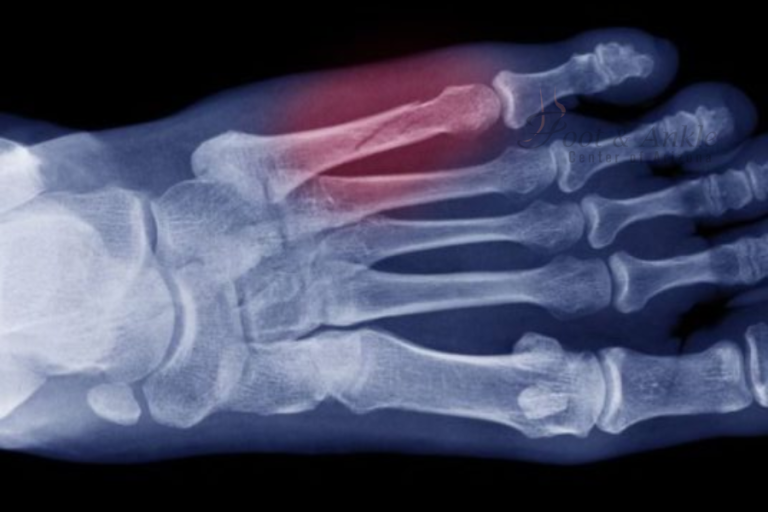Ankles are engineering marvels, bearing our weight silently and allowing us all our daily movement. Like any structure of such complexity, they are open to damage. One of the common problems involves the ligaments, the tough bands of tissue that connect bones and add stability. The lateral ankle ligaments, on the outer side of the ankle, are prone to spraining and tearing.
If you currently have a lateral ankle ligament injury, the question running through your mind has to be “How to Heal Ligaments Faster in the Ankle? The doctors running the Foot and Ankle Center of Arizona understand how such an injury may be frustrating, and limiting. Rest assured; this guide is loaded with information regarding how to heal your ligaments fast so you can get back on your feet.
Lateral ankle league explanation
The ankle joint articulates through three bones: the tibia (shinbone), fibula (calf bone), and talus (ankle bone). The lateral ankle ligaments mainly support the ATFL, CFL, and PTFL. These ligaments prevent the ankle from rotating too much outward, in a movement called eversion, which often causes sprains or tears.
Severity of lateral ankle ligament injury
An injury to the lateral ankle ligament can be a mild sprain or a complete tear. The severity will vary between treatment methods and healing time. This article gives details about the different grades.
Grade 1 Sprain: Microscopic tears develop in the fibers of the ligament. This will cause minimal pain and tenderness. There will be a small amount of swelling.
Grade 2 sprain: Ligament fibers are torn. It can cause moderate pain, swelling, and a feeling of discomfort.
Grade 3 sprain: A complete ligament rupture that causes more severe pain, swelling, bruising, and a sensation that the ankle is “giving way.”
RICE Protocol for Faster Healing
Regardless of the sprain grade, the initial approach to healing involves the RICE protocol:
- Rest: Avoid activities that place stress on your injured ankle. Note: Crutches may be used to decrease weight bearing.
- Ice: Wrap ice packs in a towel and apply it to the head for 15-20 minutes at a time, several times a day. This will help with swelling and inflammation.
- Compression: Compress and support the ankle by firmly wrapping the ankle with an elastic bandage.
- Elevation: Raise the injured ankle several inches above heart level as much as possible to reduce swelling.
Additional Tips for Faster Healing:
- Over-the-counter analgesics: Nonprescription medications include common drugs like ibuprofen or acetaminophen that can be used to alleviate pain and inflammation.
- Physical therapy: An individual can be supervised through an exercise program to increase strength, flexibility, and balance within the ankle joint, thereby gaining not only increased functional ability but a faster return to function, along with protection against future injury.
- When needed: A reasonably supportive ankle brace could help stabilize the joint and protect it as it heals.
When to Consider Ankle Ligament Surgery
Often, the conservative management measures, especially those using the RICE protocol and physical therapy, will not work. Here are some of the conditions/situations under which surgery may be a must:
- Severe – Grade 3 sprain: This usually requires surgical treatment because there is a complete tear of the ligament to regain stability around the affected joint and to prevent chronic instability.
- Chronic ankle instability: Repetitive episodes of sprain may result in wear and tear of the ligaments, thereby rendering the joints in the ankle unstable and prone to other likely injuries. The repairing of the ligaments can be conducted through surgical means to reinstate stability.
- Conservative treatment failure: Referees can consider surgical intervention if, after several weeks, symptoms such as pain and instability continue, even if the correct treatment regime has been adhered to.
Different types of ankle ligament surgery
The type of surgery to be performed depends on the degree of damage to the ligaments and the general state of the ankle joint. Here are some examples:
Arthroscopic lateral ankle ligament repair: This technique involves smaller cuts and a camera that assists in viewing the harmful part as well as mending it through sutures or anchors.
Open lateral ankle ligament repair: This entails making a bigger cut to directly reach for the ligament and perform repair.
Lateral ankle ligament reconstruction: In cases where there is a complete tear or severe stretch, a potential donor site could be taken from any other part of the body to replace the damaged one.
Duration of Ankle Ligament Surgery Recovery
The recovery period after an ankle ligament surgery varies depending on the procedure’s complexity and also your rate of healing. Generally, it may take between six and twelve months to fully recover. The following is how you would break down the normal stages of recovery:
Weeks 1-6: this involves mainly pain control, reducing swelling, and safeguarding the surgical area. In this phase, people usually walk with crutches but they don’t bear weight.
Weeks 6-12: Physical therapy helps in regaining strength, flexibility as well as range of motion in your ankle joint. The exercises will gradually progress into balance improvement and proprioception (knowing where your ankle is located relative to space).
Months 3-6: Weight-bearing activities can be gradually resumed beginning with low-impact exercises like swimming or cycling.
Months 6-12: With increased strength and stability one can return to more strenuous activities such as jogging or leaping. Nevertheless, such intensity adjustments must be made progressively so that no complications occur as a result of a sudden increase in activity level.
Importance of Following Doctor’s Instructions
What is most important when you have any type of surgery is to follow your doctor’s post-operative instructions to the letter. Now, these can be medication schedules, regular appointments with physical therapy. And advances in weight-bearing activities as recommended—all done gradually.
Benefits of Selecting Foot and Ankle Center of Arizona
We understand that patients with ankle ligament injuries need quick and complete recovery at the Foot and Ankle Center of Arizona. Our highly experienced podiatrists are experts in diagnosing and treating all disturbances related to the ankle, be it either lateral ligament sprains or tears.
We offer a comprehensive approach to healing, combining the latest treatment techniques with personalized care. This includes:
- Sophisticated diagnostic help: We use advanced X-rays, MRI scans, and whatever other methods are necessary to determine the actual level of the damage to the ligament.
- Minimally invasive surgical techniques: where possible, our Podiatrists use arthroscopic procedures, giving the patient minimal scarring and a faster recovery.
- Comprehensive Physical Therapy: Our team of physiotherapists is dedicated to designing a unique program for your condition to regain strength, flexibility, and stability in the ankle.
- Postoperative support: this involves all the post-operative support and advice regarding the journey to full recovery to assist you as much as possible back into full function.
Conclusion
Sophisticated diagnostic help: We use advanced X-rays, MRI scans, and whatever other methods are necessary to determine the actual level of the damage to the ligament.
Minimally invasive surgical techniques: where possible, our Podiatrists use arthroscopic procedures, giving the patient minimal scarring and a faster recovery.
Comprehensive Physical Therapy: Our team of physiotherapists is dedicated to designing a unique program for your condition to regain strength, flexibility, and stability in the ankle.
Postoperative support: this involves all the post-operative support and advice regarding the journey to full recovery in order to assist you as much as possible back into full function.
Healing from a lateral ankle ligament injury can be a frustrating experience, but with proper care and guidance. You can regain full function and prevent future complications. If you’re experiencing ankle pain or instability, don’t hesitate to schedule an appointment with the Foot and Ankle Center of Arizona (call us at +1 480.342.9999). Our team of experts is here to help you get back on your feet and lead an active life.
Remember: Early diagnosis and proper treatment are crucial for optimal healing of lateral ankle ligaments. If you suspect a sprain or tear, schedule a consultation with a podiatrist to receive a personalized treatment plan and get you on the road to recovery.




